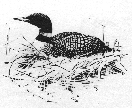The Loon Food Chain
Loons eat fish--A LOT of fish. Almost-grown loons eat about 22 percent of their total body weight in food every day, while tiny, fast-growing chicks eat more like 40 percent of their weight every day. An ornithologist once calculated that it takes a ton of fish (that's 2,000 pounds!) to feed a pair of loons and their chicks over the a single breeding season. Those must have been hungry loons!
We at Journey North calculated that the total amount of food eaten by a pair of loons and their growing chicks is about 360 kg, (792 pounds, or less than half a ton) during the 120-day breeding season. That's still a lot of food for a family of four whose total weight is only about 32 pounds at the time the young leave the nest. And that means a family of loons DOES eat well over a ton of fish during a full year.
Loons eat fairly small fish, about 10 to 70 grams each, though sometimes loons take fish up to 300 grams. How big is that? A ten-gram largemouth bass is about 4 inches long; a ten-gram bluegill is about 3 inches; a 70-gram largemouth bass is about 7 inches long; and a 70-gram bluegill is about 6 inches long. A 300-gram largemouth bass is about 11 inches, and a 300-gram bluegill is about 9 inches. Fish this large are hard for loons to deal with. Sometimes loons end up dropping larger food items, and once in a while a loon may even choke.
Loons also eat crayfish, shrimp, frogs, large aquatic insects, and other critters, especially when fish numbers are low or the water is murky.
Loon Food Chains
Loons, like other animals, get all their energy from the sun. Of course, they could sit out in the sunshine their whole lives and die of starvation! So, how can the sun be the source of their energy?
Sunlight is the source of energy for plants. Tiny plants called algae grow in lakes. Without the algae, there would be no food for any of the animals, and without the sun, there'd be no algae.
Algae are the main source of food for little animals called Daphnia or water fleas. It takes about ten grams of algae to grow about one gram of tiny water fleas.
Some aquatic insects eat these tiny water fleas. An example is the dragonfly nymph. Dragonfly eggs hatch into nymphs that live in the water for months or even years, until they leave the water, shed their final nymph skin, and open up their wings to become adults. When these adults breed, they will lay their eggs in the water to start a whole new cycle.Dragonfly nymphs eat many little creatures in the water, including water fleas. It takes about 10 grams of water fleas to produce about one gram of insect.
Small fish eat many aquatic insects, including dragonfly nymphs. It takes about 10 grams of insects to produce one gram of fish.
Some medium sized fish eat smaller fish. An example is the largemouth bass. Again, it takes about 10 grams of food to produce one gram of these large fish. In turn, the large fish are food for other living thingsñlike loons!
Loons eat the fish, and it takes hundreds of grams of fish to produce one gram of loon. Since one loon weighs about 5000 grams, this means it takes about 500,000 grams of fish to make one loon!
Activity
- A food chain is a simple drawing to illustrate how each animal eats some things and is eaten by others. Have
students illustrate the loon's food chain starting with the sun and going all the way up to the loon. They should
include labels for each trophic level, or food level, and a title for the completed page.
- Students may wish to work in groups or pairs, adding facts or math questions to their food chains to challenge
other students.
- Use student-created illustrations for each part of the loon's food chain, or download
and reproduce the illustrations you see on this page.
- Discuss: Why does the loon need so much more food for its weight than fish, insects, or water fleas need? (Hint: Consider whether a species is warm-blooded or cold-blooded, and what this would mean for food requirements.)
Extensions
- Food chains are one way of showing the food levels. Another way is a food pyramid. For example, one food pyramid for loons would have a large base: the algae. Ten thousand pounds of algae would produce a thousand pounds of daphnia, so this level of the pyramid would be smaller. A thousand pounds of water fleas would produce a hundred pounds of tiny fish. And a hundred pounds (or more!) of fish would produce just one loon. Use this information to draw a loon's food pyramid.
- Another Loon Food Chain. Eventually plants and animals die. Those that live in the water slowly sink to the bottom, where their bodies are eaten by scavengers. Crayfish spend a lot of time scavenging on these bodies. Sometimes loons eat crayfish. Discuss: Is the sun the original source of energy for this food chain? Why or why not? Draw this short food chain.
|
 Large Mouth Bass |
 Green Algae |
 Water Fleas |
Nymph |



